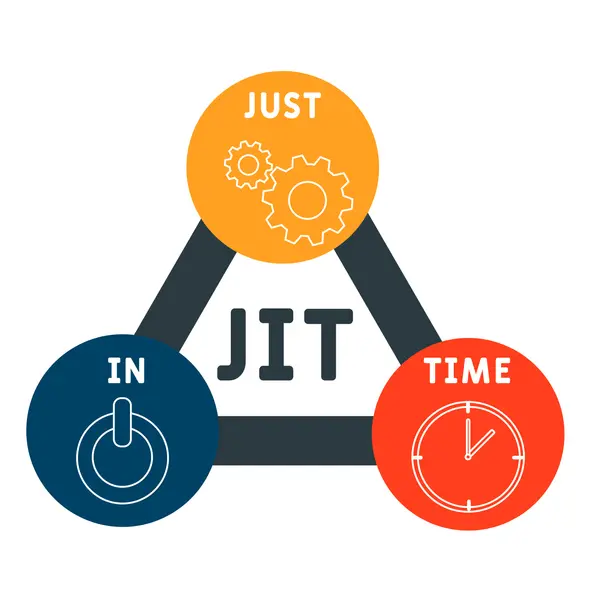Inventory management is vital for businesses, impacting finances, operations, and customer satisfaction. It optimizes costs, ensures products meet demand and efficiently manages cash flow. Businesses can analyze inventory-related data to plan in advance, giving them a competitive edge and the ability to swiftly respond to market changes.
Just in Time (JIT) inventory, the hero of this article, is an inventory management strategy focused on receiving goods only as needed, reducing excess stock and associated costs. In a modern supply chain, JIT enhances efficiency by minimizing waste, streamlining production, and fostering closer supplier relationships. Let us delve into the world of the flexibility and improved efficiency that the JIT inventory management method offers, looking at its definition, benefits, and uses.
What is Just in Time Inventory
Let’s define Just in Time. A Just in Time (JIT) system is an inventory management and production strategy where goods and materials are acquired, produced, or delivered only as needed to meet customer demand… just in time as the products are needed. It aims to minimize inventory levels and associated costs by synchronizing production closely with demand, ensuring items are available precisely when required.
There are various approaches to inventory management, some of which can be classified as either a “push” system or a “pull” system, dependent on the replenishment of inventory and production. A Traditional Push System bases production on forecasts or predetermined schedules. Goods are produced and “pushed” into the inventory based on these forecasts. However, this often leads to overproduction and results in excess inventory. Inventory levels are then maintained based on future demand; thus, excess inventory is required.
JIT is a Pull System, where production is driven by demand. Goods are produced and replenished in response to actual orders. As an order is received, the production process is triggered, and the materials are ordered for the specific order. Thus, as the order is placed, the materials and goods required are “pulled” through the supply chain.
Just in time systems have been implemented across various industries. Retailers such as grocery stores apply JIT principles to restock their perishable goods and consumer products based on real-time sales data, with specific reordering point triggers. JIT systems are also used in the automotive industry. These businesses maintain lead production by receiving parts and components of vehicles from suppliers precisely when they are required in the assembly line. This minimizes storage costs and excess inventory.
History and Origin of JIT
The Just in Time production system originated in post-World War II Japan, primarily through the work of Toyota and influential figures like Taichi Ohno and Eiji Toyoda. Facing resource scarcity and economic challenges, Toyota sought ways to improve efficiency. Taichi Ohno, an engineer at Toyota, is credited with architecting JIT, focusing on waste reduction in production processes. Consequently, Toyota began creating only what’s needed, when needed, and in the necessary quantity. Toyota’s success with JIT attracted global attention, leading to widespread adoption of these principles across industries, shaping modern lean manufacturing practices worldwide.
JIT systems have evolved over time, extending far beyond its roots in manufacturing. Initially focused on inventory control, JIT principles have expanded across industries, integrating technological advancements like real-time data analytics for precise demand and inventory forecasting and efficient supply chain management. Globalization introduced complexities but also widened access to a greater market of suppliers, which brought closer collaboration between parties in the supply chain. JIT has shifted towards holistic process optimization. Enhanced supplier relationships and a growing focus on sustainability have further shaped JIT’s evolution. Today, the concept of JIT systems embodies a comprehensive approach, aligning operations, technology, and strategy to not only minimize waste and optimize efficiency but also ensure adaptability and resilience in an ever-evolving business landscape.
How JIT Works: A Step-by-Step Process
Just in Time operates with a customer-centric ethos, aligning production precisely with customer demand to minimize wait times and ensure products are available when needed. Its focus on quality, flexibility, and continuous improvement aims to meet evolving customer expectations.
Suppliers are critical partners in a JIT system, providing timely, high-quality materials aligned with production needs. Close collaboration, facilitated by long-term contracts, fosters trust and enables suppliers to deliver small, frequent batches as required, minimizing inventory costs. Shared information and stringent quality control are essential, ensuring smooth operations and high-quality output. These supplier relationships not only support efficient production but also mitigate risks, contributing significantly to the success of the JIT model.
What are the just in time operations? The process in a JIT system follows a tightly orchestrated sequence from order placement, right through to product delivery:
- Order Placement:
Orders are placed based on real-time customer demand or predetermined schedules. This triggers the production or procurement process through direct customer orders or point-of-sale data. - Production Initiation:
Upon receiving an order, the production process starts. JIT prioritizes producing only what’s necessary to fulfill the order. This is often guided by electronic systems to prompt production activities. - Material Procurement:
JIT relies on suppliers to deliver materials or components precisely when needed. Suppliers typically provide small, frequent batches of materials, aligning with the production schedule. This ensures that the manufacturer receives materials just in time for production to ensure storage costs and excess inventory are reduced. - Assembly and Manufacturing:
In the manufacturing facility, JIT manufacturing optimizes the layout and workflow to improve efficiency. Workstations are arranged in a way that allows for a smooth, continuous flow of materials and products. The emphasis is on minimizing waiting times, reducing setup times, and maximizing production speed while maintaining the quality of the product. - Quality Control:
Rigorous quality checks are performed throughout the production process. This involves regular inspections and testing to ensure products meet specific standards. Any defects are immediately addressed to prevent disruptions in the production flow and to maintain quality products. - Packaging and Shipment:
Finished products are packaged as soon as they’re manufactured. JIT emphasizes quick turnover in packaging to reduce excess inventory. Products are prepared for immediate shipment, often with minimal handling or storage between the production and delivery stages. - Delivery to Customer:
Once packaged, products are promptly delivered to customers. JIT aims to minimize lead times between production and delivery, ensuring that products reach customers swiftly and meet their specified timelines or expectations.
Advantages of JIT
JIT boasts numerous advantages for inventory management. JIT’s approach to inventory results in cost savings, waste reduction, increased productivity, efficiency, quality, and flexibility.
Cost Savings: JIT’s minimization of inventory levels significantly reduces holding costs, resulting in lower expenses related to storage, handling, and inventory obsolescence. This lean approach to inventory optimizes resource allocation, which in turn, lowers overall operational expenses.
Waste Reduction: JIT aims to eliminate overproduction, excess inventory, and inefficiencies. This lean methodology drastically reduces waste, promoting a more environmentally sustainable and cost-effective production model.
Increased Productivity and Efficiency: By aligning production precisely with demand, JIT enhances operational efficiency. Its streamlined processes minimize idle time, reduce wait periods, and optimize resource utilization, ultimately boosting productivity levels.
Improved Product Quality: JIT emphasizes stringent quality control measures and continuous improvement. By focusing on smaller, more manageable batches, it ensures higher product quality, reducing defects and related costs.
Flexibility: JIT’s agile approach allows for rapid adaptations to changing market demands. It enables swift adjustments in production schedules, facilitating responsiveness to fluctuations in customer preferences or market trends, by allowing businesses to respond appropriately as orders are made.
Challenges and Drawbacks of JIT
Although there are many benefits to a JIT System, there are a couple of challenges associated with implementing JIT into a business’ inventory management strategy.
Higher Inventory Costs in Disruptions: JIT’s reliance on lean inventory can backfire during supply chain disruptions. Any delay can lead to shortages, halting production or causing stockouts. To offset these risks, it is essential to maintain safety stock, which increases inventory costs.
Vulnerability to Supply Chain Disruptions: JIT heavily depends on timely and consistent supplier deliveries. Any disruption, be it due to natural disasters, geopolitical issues, or supplier problems, can disrupt production schedules, causing significant setbacks.
Risk of Misjudging Customer Demand: JIT systems are sensitive to demand fluctuations. Misjudging or inaccurately forecasting customer demand can lead to stockouts or excess inventory, affecting production efficiency and potentially causing customer dissatisfaction.
Staffing and Training Challenges: JIT requires a highly skilled workforce capable of adapting quickly to changes in production schedules and demand. Proper training and efficient coordination are essential. Staff shortages or inadequate training can hinder the smooth operation of JIT systems.
Addressing these challenges often involves balancing the efficiency of JIT with strategies to manage uncertainties, such as maintaining contingency plans for supply disruptions, implementing robust demand forecasting techniques, and investing in continuous training and skill development for employees to adapt to changing production requirements.
Implementing JIT In Your Business
Transitioning to a Just in Time (JIT) system involves several crucial steps and best practices. It begins with assessing current processes, inventory levels, and supply chain dynamics. Close collaboration with reliable suppliers is essential, establishing clear communication and mutual goals for timely deliveries. Analyzing and gradually reducing excess inventory while refining demand forecasting ensures smoother alignment with customer needs. Optimizing production processes, emphasizing quality control, and training employees on JIT principles are key components. Starting with a pilot program helps identify challenges and refine processes before full-scale implementation. Continuous improvement, technology integration, and risk mitigation strategies round out the transition, emphasizing adaptability and constant refinement for optimal JIT success.
Selecting the right suppliers and cultivating strong relationships holds paramount importance within a JIT system. These partnerships ensure timely deliveries, maintaining the precision required to avoid disruptions in production schedules. Trusted suppliers contribute to higher-quality materials, reducing the risk of defects and delays. Collaborative relationships facilitate agility, allowing adjustments to meet changing demands swiftly. Reliable suppliers play a crucial role in minimizing lead times and enhancing supply chain resilience during disruptions. Such partnerships foster continuous improvement, encouraging shared goals and innovations that contribute to the efficiency and effectiveness of the JIT system.
JIT inventory management relies on technology-driven software solutions that streamline operations and align with JIT principles. These tools encompass demand forecasting, inventory management, and supply chain visibility, ensuring precise production planning and lean manufacturing practices. JIT software facilitates real-time monitoring of inventory levels, enhances production schedules, and supports quality control efforts. Integrated systems offer comprehensive analytics, aiding in data-driven decision-making and continuous improvement. Ultimately, JIT software optimizes workflows, minimizes waste, and enhances efficiency by leveraging technology across the supply chain.
Case Studies
Many businesses have implemented JIT systems, however, we shall examine how Toyota and Dell offer valuable lessons and key takeaways from their successful implementations of JIT principles:
Toyota
Toyota’s focus on waste reduction within its Toyota Production System (TPS) remains a foundational lesson. Eliminating waste in all forms, from excess inventory to inefficient processes, is crucial for efficiency. Toyota has also focused on building strong relationships with suppliers, which has been integral to Toyota’s success. Collaborative partnerships ensured timely and high-quality deliveries throughout the manufacturing process. Their commitment to the principle of kaizen (continuous improvement) is a cornerstone lesson that can be applied to JIT system. Toyota encouraged employees at all levels to identify and solve problems, leading to ongoing enhancements. Their JIT system emphasized flexibility, enabling rapid adjustments to production schedules and inventory levels based on changing customer demands. And finally, Toyota maintained a relentless focus on quality throughout the production process, ensuring defect-free output and customer satisfaction.
Dell
Dell’s success with JIT came from its build-to-order strategy. Producing customized computers only after receiving orders minimized inventory and reduced costs. Their close collaboration with suppliers allowed for swift component deliveries, enabling the company to maintain minimal inventory levels. Dell used their JIT model to emphasize responsiveness to market changes and customer demands, allowing quick adjustments in production to match evolving preferences. They ensured their approach centered around efficiency and a customer-focused strategy, tailoring products to individual needs without overproducing. Dell’s success highlighted the importance of lean operations, precise inventory control, and the reduction of waste in a highly competitive industry.
These lessons from Toyota and Dell underscore the importance of lean operations, supplier collaboration, continuous improvement, and a strong customer-centric approach in successfully implementing JIT principles across diverse industries.
Alternatives to JIT
It is also important for businesses to explore other inventory management systems. There are various number of inventory management strategies. Two core approaches, besides from JIT, are Just in Case (JIC) and Just in Sequence (JIS).
Just in Case inventory management is a strategy where businesses maintain larger-than-needed inventories as a precautionary measure. The aim is to have surplus inventory on hand to meet unexpected increases in demand, supply chain disruptions, or unforeseen contingencies. This approach prioritizes stockpiling inventory to prevent stockouts or production delays. JIC aims to ensure a safety net of resources, though it often leads to higher holding costs, increased storage requirements, and potential obsolescence.
Just in Sequence (JIS) inventory management is a strategy primarily used in manufacturing. It involves the precise delivery of parts or components in the exact sequence required for production. Unlike JIT, which focuses on the timing of deliveries, JIS emphasizes the order and sequence in which materials arrive at the production line. JIS is crucial in assembly operations where components must arrive in a specific sequence to facilitate immediate use in the manufacturing process, reducing handling and storage requirements.
In essence, JIT prioritizes lean operations and efficiency by minimizing waste and inventory, while JIC and JIS focus more on risk management, ensuring resources are available in case of unexpected situations or specific assembly requirements. However, JIC and JIS have potentially higher costs and inventory levels to ensure this level of safety.
Why Consider JIT: Final Reflections
JIT presents a transformative force reshaping business processes. Its impact reaches across operational efficiency, cost reduction, and enhanced quality, fundamentally altering how businesses approach production and supply chain management. JIT’s lean principles streamline processes, curbing waste and optimizing inventory, leading to profound cost savings and heightened productivity. Quality improvements, fostered by continuous enhancement and stringent control, ensure higher customer satisfaction. JIT’s customer-centric approach aligns production precisely with demand, reducing lead times and elevating delivery efficiency. Encouraging collaboration with suppliers, it enhances supply chain resilience and adaptability. JIT’s transformative potential lies in fostering innovation, adaptability, and a holistic approach to business operations, ensuring sustained success in dynamic markets.
For businesses contemplating the adoption of a JIT system, several critical considerations must guide their decision-making. First, assessing supply chain stability is essential, ensuring suppliers can consistently deliver on time. Operational readiness is crucial; streamlining processes, investing in technology, and training employees prepare the ground for JIT implementation. Understanding demand variability and aligning JIT with stable demand patterns is essential for success. Strict quality control measures and contingency plans for disruptions are vital to maintaining production standards and resilience. While JIT promises long-term benefits, initial costs and the need for a cultural shift within the organization should be weighed. Strong supplier relationships, adaptability to change, and fostering a culture of continuous improvement form the bedrock for JIT’s successful integration into business operations.
Find out how Intuendi’s accurate forecasting and ability to streamline replenishment can assist in the implementation of JIT.






